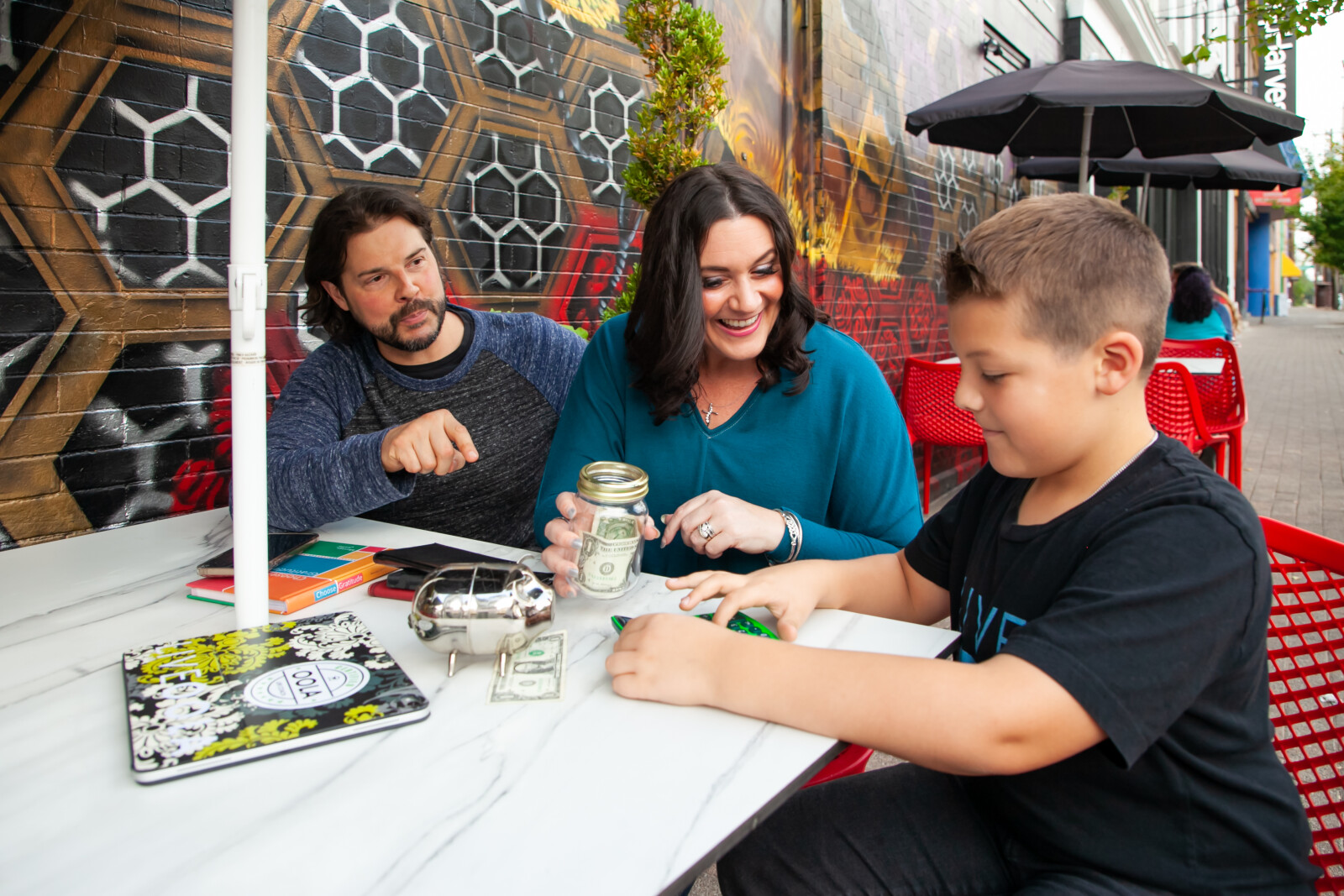
Is it just me or is it sometimes hard to make really good friendships as an adult?
And if that alone isn’t hard enough, there’s the added pressure to make sure your spouse clicks with theirs, the kids all get along, everyone’s schedules line up… Even the thought of setting all that up is exhausting!
I know you feel me on this one; adult friendships are not always easy, but they’re so worth it. When times are tough, you need a little support, or are looking for advice from someone in a similar life stage, your friends are your network and your community.
Let’s talk about some practical ways to build and maintain solid, lasting friendships at any age.
What kind of friendships do you have?
Think about your current circle or network: Who is in it? Who do you talk to regularly? Who is important to you?
They say you’re most like the top 5 people you spend time with, so these people are key. Are they living lives you admire?
If this close circle is made up of people you admire, respect, or click well with, you’re likely on the right track. Making new friends is awesome, but also remember to keep these people close to you and appreciate them if they are relationships you want to maintain.
Make a note to call or plan a coffee date with them; texts and social media interactions are great, but nothing can replace a good conversation. Making time for this not only strengthens your friendships, but also fills your cup energetically.
Humans are hardwired for connection. Investing time in relationships is not frivolous, it’s necessary!
Making new friends as an adult
Maybe you scrolled right on down to this part, because honestly this is the ultimate question for so many. Gone are the days when you could just plop yourself down next to another kid in the sandbox and become instant best friends. Now this stuff takes some work!
Some questions to ask yourself: Who do you wish you had more contact with? What type of person would you love to meet in this season of life? What are your current priorities, and where might a friendship fit in well?
Maybe there’s someone you lost touch with and you’d like to reconnect. Maybe you’ve picked up a new hobby and you’d like somebody to go to yoga class with you. Maybe your pre-teen is going full-on teenager mode and you want to find another parent with kids of a similar age to just talk through all the changes together.
You’d be surprised how many new friends are probably waiting for you to find them and initiate the conversation. That old connection might still have the same email address. Someone at church might be curious to try yoga with you. That parent ahead of you in line at the school drop-off might want to swap parenting secrets over lunch.
When you open yourself up to new friendships, they just might start to appear.
Why bother making and keeping friends?
Solid friendships are a two-way street: there’s effort and reward on both sides of the equation. Good friends will help keep you accountable on your goals, comfort you when life is rough and lift you up when you are ready to quit. Having and being a good friend is essential to living a full life.
Friendship is so important, it’s one of the 7 Oola pillars for a balanced life. Oola has been such a blessing to me in a million ways, but one of the best has been the lasting friendships it’s brought me! They’re strong men and women who are in my corner, and also going after their own OolaLife.
If you’re ready to take charge of your life, too, and start finding balance in all 7 areas, let’s talk! I became a Certified Oola Life Coach because I saw the positive impact it had on my life and the lives of those close to me. I can’t wait to help you create that in your own life, too!earn more about Oola
“Friendship takes work. Finding friends, nurturing friendships, scheduling face time, it all take a tremendous amount of work. But it’s worth it. If you put in the effort, you’ll see the rewards of positive friends who will make your life extraordinary.”
Maya Angelou

Setting goals sounds great at first. New Years Eve rolls around and it feels like a fresh start! Then suddenly it’s January 2nd and the gym shoes are nowhere to be found. Resolutions are already broken before they’ve even started.
Is this you?
When it comes to setting goals, you might find yourself in one of two common patterns:
- You’re motivated by a fresh start: New year, new month, new week, new you! But as soon as you slip on spending, or skip a day at the gym, all bets are off. Maybe next month.
- There are so many things you want to accomplish, but they feel too far away from where you are now. You aren’t even sure what the first step is, so you keep putting it off until you have time to figure it out.
Friend, I’ve got you! Whether you’re struggling to find motivation or just need help defining and clarifying your goals, this is for you.
Let’s talk about 4 steps to help you achieve your goals.
1. Challenging but attainable
When mapping out your goals, it’s important to keep this balance in mind. If the goal is too easy it won’t really stretch you or make much of a difference in the long run. If it’s too difficult, you might get discouraged and not follow through.
For example, maybe you want to read more in the coming year. If last year you averaged one book per month, a good goal for you might be to read two books per month next year. That would be a significant stretch, but not impossible. On the other hand, an unrealistic goal in this case might be to read one book per week. If you aren’t a big reader, this is not a goal you’ll enjoy or realistically be able to complete.
The point of setting goals in the first place is to take steps of growth that lead you to bigger accomplishments. Think about it like being on a boat in the middle of the water, and the shore is your ultimate ambition. In order to set foot on the shore, you have to first make moves to bring the boat closer to the dock.
2. Dream big
While we do want to keep our goals realistic and achievable, it’s also important to dream big for your life! Goals are the steps we take to get where we ultimately want to go. Make sure those steps you’re taking are leading you intentionally toward your biggest ambitions.
An awesome way to approach goal-setting is to reverse engineer the whole process. Start with the end in mind and work backward.
Block out 10 minutes of your day to sit down and really focus on this. Think critically about what you want your life to look like in 5, 10, or 20 years and practice actually picturing it. Where do you live? What does your day look like? Who is with you? What are you wearing? What are you eating?
Some of these questions might seem silly, but thinking about those details gives your powerful brain a kind of map to steer you toward (read up on growth mindset and neuroplasticity for more about this!) When you can clearly envision where you’re headed, the steps to get there will become clearer.
3. Write it out
Your brain is incredible, it’s true. But DO NOT rely on it to track every single thing you’re working toward. The act of writing your goals down, as in physically writing with pen and paper, helps connect your brain to the mission at hand. Studies have shown that written goals are much more likely to be accomplished than those that are just thoughts.
Writing out your goals by hand accomplishes a few things:
- The motion of your hand writing out words sticks with you more than typing.
- Writing helps you process and clarify your thoughts.
- You may choose to keep your written goals somewhere you’ll see them often, which only increases the likelihood that you’ll follow through.
Whether you choose to journal, make a list, create a vision board, or jot some words on a napkin, get those goals out of your head and onto paper.
4. Be SMART
You’ve likely heard of SMART goals at some point in your life, and for good reason. This is an acronym to help guide in the goal-setting process. When working through your goals, keep in mind the SMART goal pillars:
- S – Specific (Answers the Who, What, When, Where, Why details of your goal)
- M – Measurable (How much/ how many/ how will I know when it’s accomplished?)
- A – Achievable (Is this actually possible?)
- R – Relevant (Is this the right time? Does this seem worthwhile/important?)
- T – Time-bound (Has an end/ expiration date)
Example: Your family needs to get a second car so that everyone can get to work, school, and activities, and you want to pay for it in cash (Specific). You have money saved for the car, but need to find an extra $5k to pay for it in full (Measurable). That extra $5k will be a stretch, but you’re pretty sure you can make it happen if you tighten up the budget and get a little creative (Achievable). This is something that has needed to happen for a while since your oldest got their license and everyone has somewhere they need to be (Relevant). You need to have the car by the time the kids go back to school in the fall (Time-bound).
Sketching out your goals this way sets you up for success! When our goals are unclear or not detailed enough (i.e., “I want to read more” or “I want to workout”) they’re not really goals at all.
Go after your biggest goals!
As they say, anything worth doing is worth doing poorly at first. Success is never guaranteed, but approaching your goals and dreams with intention will set you up for better results and clearer progress.
Some goals are not going to fulfill you. Choose goals that you value and care about.
Henry Cloud

Sharon Davenport’s life mission of helping people began as she was growing up in her family’s Kentucky home. Her parents fostered a loving environment with pizza-and-soda Family Fun Nights, and affectionate rituals like back rubs and foot rubs while sharing about each other’s day.
“My mom was my first life coach and the most important person in my life,” Sharon, who has nearly two decades of experience in health, wellness and personal development, says as we sit down for our interview. “We were extremely close—really, we were best friends.
Read the complete interview at Thrive Global.

Saying “I love you” to your family as often as possible is very important! It turns out there’s actually more than one way to say it. Dr. Gary Chapman theorized in his book The Five Love Languages that there are five ways people give and receive love. Read on to learn what the love languages are and how they can apply to you and your family:
What are the Five Love Languages?
Here is a description of each of the Five Love Languages:
- Acts of Service: To a person with this love language, actions speak louder than words. Essentially, it means completing tasks for a loved one or helping complete a task. Examples might be a husband doing a household chore he knows his wife dislikes, an older child helping a young sibling with a school project, proofreading a resume for a friend, or helping a neighbor move into a new house.
- Quality Time: Quality Time means more than just occupying the same space. People who value this love language especially appreciate attentiveness and good listening skills. Planning to participate in fun activities together, ensuring you eat meals together, or even working together can count as Quality Time.
- Words of Affirmation: This involves giving compliments, encouragement, or words of appreciation. Examples might be: “You look sharp in that outfit!” or “Thanks for always making us feel so welcome” or “You are such an interesting conversationalist!” You can simply say these compliments aloud or write your loved one a note telling him or her what you appreciate about them.
- Receiving Gifts: Gift-giving doesn’t have to be reserved just for Christmas and birthdays. People with this love language enjoy receiving gifts that show people understand and are thinking of them. Gifts don’t have to be anything elaborate. Bringing home treats from the bakery for the kids, sending flowers to your grandma, or bringing your wife her favorite Starbuck’s coffee to her office are all simple ways you can show love to someone whose love language is Receiving Gifts.
- Physical Touch: People with this love language feel the most loved through physical touch that can include hugs, kisses, holding hands, or massages.
The Five Love Languages and Your Family
It’s a good thing there’s more than one way to say “I love you” because you can creatively express your love and appreciation to your family in many ways. However, it can create some confusion if your family members have differing love languages and don’t recognize your efforts. For example, if a wife’s love language is Quality Time, she may appreciate flowers from her husband but will feel much more loved if he plans a night out participating in her favorite activities. Learning someone’s love language can also help you avoid creating circumstances that would be particularly hurtful for them. For example, while hearing criticism or verbally expressed disappointment isn’t pleasant for anyone, it can be especially painful for someone whose primary love language is Words of Affirmation.
Chapman noted that most people give and receive love using the same love language, but this isn’t always true. Also, some people have more than one. A survey based on 10,000 responses indicated that the most common love language is Words of Affirmation.
So which is your primary love language? You may already know based on your life experience. If you’re not sure, you can take the official quiz online here. It can help you determine what your primary love language is. The quiz can also help you figure out the love language(s) of your child(ren). “Children receive love emotionally,” Chapman said, “but because they are all different, we must pay attention to their individual needs. We must learn to speak our children’s [love] language if we want them to feel loved.”
Additional Love Language Resources
Chapman wrote an entire book about how these concepts apply to family. Check out Five Love Languages of Family or The 5 Love Languages of Children to learn more.

Every year, National Family Health & Fitness Day is celebrated on the last Saturday in September. This year, it falls on Saturday, Sept. 29. Stay informed regarding best practices for your family’s health and fitness and get moving to celebrate National Family Health & Fitness Day this weekend!
The Purpose of National Family Health & Fitness Day
The Health and Information Resource Center established National Family Health & Fitness Day in 1996 to encourage people of all ages to prioritize physical activity.
About 80.2 million Americans over the 6 of six are physically inactive. Physical inactivity is a leading cause of disease and disability, according to the World Health Organization. Some risks of physical inactivity are high blood pressure, type 2 diabetes, heart disease, and depression. Today, many children enjoy sedentary activities like playing video games, surfing the web, and using social media. Children learn by example, so it’s very helpful for them to see their parents maintaining healthy lifestyles through exercise. When families participate in enjoyable activities like hiking, biking, tag, or kickball together, children learn that exercise is fun and begin to establish positive habits that can last a lifetime.
How to Celebrate National Family Health & Fitness Day
“When planning family activities around movement, it is important to make fun the overriding factor,” said Gregory Florez, the senior advisor on workplace leadership and vitality for the American Council on Exercise. “In fact, don’t even use the word exercise. Think of using games, competitions, etc.”
Here are some ideas for activities you can do with your family on Saturday to celebrate National Family Health & Fitness Day:
- Take a hike at a local park
- Teach your kids a game you played as a kid like Kick the Can, Capture the Flag, or Spud.
- Take a bike ride to explore a new part of town (make sure it has sidewalks/safe places to bike!)
- Host your own family Olympics. Make up your own competitions, like hopscotch, relay races, and jump rope.
- Have a water gun or nerf gun war.
- Play tag at the park or in the backyard.
- If it’s a rainy day, play laser tag or go roller skating!










